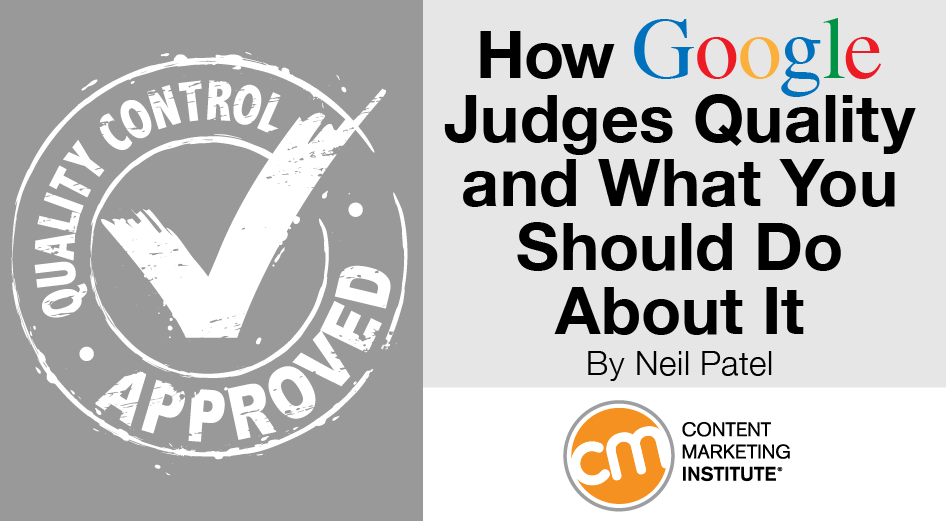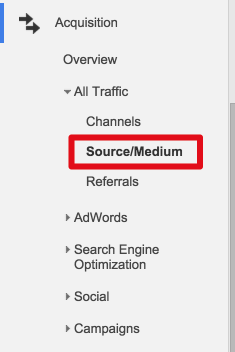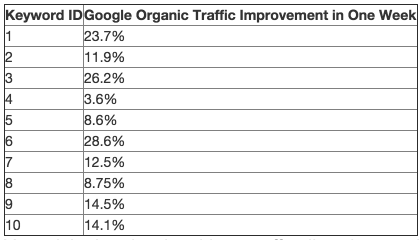Every content marketing professional has something to say about “quality.” The word has become so used – or overused – that we’ve forgotten what it is, or even why it’s important.
I think we need to press the reset button on the quality discussion. Why? Because many content marketers:
- Mistake what quality is
- Focus on the wrong kind of quality
- Misunderstand why they are producing quality content
- Do not produce quality content at all
Much of today’s content has quality, but the quality is misguided or poorly aligned in a changing content marketing environment. I don’t pretend to set the world straight, but I do propose a series of adjustments that will make your content possess true quality and rise like cream to the top.
Why is content quality important? Google says so.
There are dozens of good reasons why quality content is important. I want to focus on a single reason.
Content quality is important because Google thinks it’s important.
Many marketers have a love-hate relationship with Google. They hate Google because of its vast control. They love Google because of its vast source of inbound traffic. Let’s take a broad look at why Google matters and then we’ll get specific about content.
Google is the world’s primary search engine.
There’s no one bigger than Google when it comes to search. Despite the household-name status of companies like AOL, Yahoo, and Bing, Google is still the dominant search engine.
As of the time of this writing, the search headlines are reporting that Google’s market share is sinking. Yes, Google is shedding vast quantities of search engine traffic. But what does this mean?
Not much. Whatever “drop” there is hasn’t done much to harm its overall dominance:
Of the top five U.S. search engines, Google is indisputably on top.
For the foreseeable future, Google is the No. 1 search engine in the world.
Google sends you more traffic than other sources.
Because it is the largest search engine in the world, Google is also the one responsible for sending more traffic to websites.
To illustrate this, I grabbed a random example from one of my sites in Google Analytics. Here’s what I see.
Google is driving more than 70% of my organic traffic. If you question these numbers, then do this experiment on one of your websites.
Go to Google Analytics and select your site.
- Click Acquisition
- Click All Traffic
- Click Source/Medium
Check the numbers. If your site is typical, then you’ll see at a glance how powerful Google is as a traffic driver. But maybe your analysis is somehow skewed. Perhaps the global numbers are different? All right, let’s go check out the real-time web analytics that analyzes global queries.
In this screenshot, notice that Google still is swallowing more than 60% of the global search engine desktop market share.
When we dive into mobile traffic, Google’s share is even larger. More than 92% of the search traffic in the world is coming from Google queries.
Baidu is a Chinese search engine, which means that if you serve a primarily English market, you can remove the Baidu slice of the search pie.
But what about direct traffic, referral traffic, newsletter click-throughs, QR codes, and social media traffic? Don’t those count for something?
Yes, but from a quantity perspective, it’s not a huge source. In one study, Shareaholic quantified “share of visits” that accounted for direct traffic, social referrals, organic search, paid search – everything. Google still came out on top:
Shareaholic’s analysis is indisputable: “Google is every successful search marketer’s best friend, claiming a 31.04% share of traffic.” By comparison, all the other search engines are garnering paltry single-digit percentage points in the search engine traffic game.
In fact, as Shareaholic points out, “Google alone sends nearly 17 times the amount of visits Yahoo, Bing, Ask.com, and AOL send to publishers, combined!”
Google only ranks your site if it has high-quality content.
I took time with those statistics because I wanted to lead up to the clincher.
Google will only give you search traffic if you have high-quality content.
Yes, Google is vast. Yes, the highest percentage of your visits comes from Google. But you don’t get this traffic just by existing. You get it by producing high-quality content.
There is no other way. That point is the subject of the rest of this article.
Here are the questions I want to answer:
- How do we know that Google wants high-quality content?
- How can my site have this kind of great quality content?
How does Google show its preference for quality content?
Google Webmaster guidelines deal with the importance of quality content.
The first and most obvious way that Google insists on quality content is by telling us it’s so. Webmaster Tools is full of information that insists on valuable content.
Google even created a course for it.
The Quality Guidelines are the single most important way that Google conveys its standards.
Here is the list of things that you are asked to avoid:
- Automatically generated content
- Participating in link schemes
- Creating pages with little or no original content
- Cloaking
- Sneaky redirects
- Hidden text or links
- Doorway pages
- Scraped content
- Participating in affiliate programs without adding sufficient value
- Loading pages with irrelevant keywords
- Creating pages with malicious behavior, such as phishing or installing viruses, trojans, or other badware
- Abusing rich snippets markup
- Sending automated queries to Google
And, here are the actions Google encourages:
- Monitoring your site for hacking and removing hacked content as soon as it appears
- Preventing and removing user-generated spam on your site
In its “detailed tips for creating a Google-friendly site,” Google explains additional features of quality content:
Provide high-quality content on your pages, especially your homepage. This is the single most important thing to do. If your pages contain useful information, their content will attract many visitors and entice webmasters to link to your site. In creating a helpful, information-rich site, write pages that clearly and accurately describe your topic. Think about the words users would type to find your pages and include those words on your site.
Google employs human raters who analyze sites for quality, and thus adjust the algorithm to identify high- and low-quality features.
It is widely known among the search community that Google has a document known as the Quality Rater Guidelines. This document, which has been leaked numerous times, essentially discusses the features of good quality and poor quality. The document is not significant in its detail as much as in its overall message.
The message is this: Google cares about high-quality content. It cares enough to employ a small army of raters who can identify quality and report their findings to Google.
Here are the broad features and recommendations of the Quality Rater Guidelines that can help you create higher quality content:
- Write at an expert level. Articles that are obviously written by a novice do not qualify as quality.
- Focus on a great user experience. The best thing you can do for quality is to create a great experience for users. The quality guidelines call for a “satisfying user experience on the page and website.”
- Create more content. Google obliquely remarks, “a high-quality rating requires a satisfying amount of website information.” How much website information is a “satisfying amount”? It’s anyone’s guess, but we do know that the top results in the Search Engine Results Pages (SERP) have thousands of words on a single page. More is better.
- Interact with other relevant and authoritative sources. In keeping with co-citation and co-occurrence best practices, make sure that you reference any authoritative sources and draw upon other recognized resources.
- Make sure your site has easily accessible contact information. Whether you’re an individual, a company, or a content site, make sure your site has the marks of a real site – name, address, phone number, etc. A quality website is backed by real people.
- Keep the content fresh. Content ages and Google wants to see that pages are being updated and reviewed on a regular basis.
Google’s algorithm updates reflect the importance of content.
Google’s much-famed algorithm updates are designed to improve the search engine’s ability to rank sites. But which sites get higher rankings? And which sites get ranked lower? And why?
The formula takes into consideration a huge variety of factors, but one of the biggest ones is content. The name of this algorithm update is Panda.
Google has had more Panda updates than any other publicly known updates. As of early 2015, there are 27 Panda updates on record. The most recent major Panda update happened in September 2014.
Panda is, technically speaking, a search filter. It first appeared in February 2011. The entire point of the filter is to downgrade the search rankings of sites that have low-quality content.
The Panda features are broad and varied, but here are some of the main things that Panda attempts to weed out:
- Duplicate content – content that appears on more than one page (Content needs to be unique.)
- Automatically generated content
- Affiliate pages that don’t actually say anything substantial
- Doorway pages
- Scraped content
- Some guest posts
- Unauthoritative content – content that does not augment the general knowledge on a given topic
- Content stuffed with keywords
Is your site a victim of Panda’s updates? Check out this flowchart, and see if anything stands out.
The fact that Google has updated Panda so many times indicates how important it considers high-quality content to be.
Google penalizes low-quality content
How important is quality, really? It’s important enough to warrant a lot of time, attention, and effort on your part. Many webmasters have war stories of Panda updates. Some of these Panda tragedies obliterated virtually all of a site’s organic traffic.
This site, for example, experienced a blow-after-blow attack from Panda’s updates, spanning nearly a year and a half.
Can your business sustain that kind of traffic drop-off?
I didn’t think so.
Thankfully, recovery is possible. The Google Analytics traffic report above is an abysmal loss, but that same site experienced rapid recovery – gaining back huge percentages of search in a matter of weeks.
In its guidelines, Google makes it clear that it will take manual action against sites that are not in compliance with its guidelines.
Practical takeaways for creating high-quality content
The issue of quality is so huge that you could read hundreds of articles and still not exhaust the subject. It’s also an unwieldy subject. Quality can affect details as minute as kerning, and fuzzy issues like authority. How do you wrap your mind around it?
Here are a few solid takeaways that will allow you to create a high-quality site:
- The content on the page should be unique. If it isn’t unique, it must make proper use of canonical tags. For a handy guide on canonicalization, please refer to Moz’s excellent resource.
- Don’t stuff the page with keywords.
- Make it easy for users to navigate to other portions of the site, especially areas of the site that have similar content. In other words, create internal links to other articles or pages that shed light on the subject under discussion.
- Make sure that the content is long enough to treat the subject with sufficient detail. There is no word count that works well for every subject.
- Each article should be about a single subject.
- The web page as a whole should support that single subject.
- Affiliate links or ads tend to detract from the page experience. Use them with caution or not at all.
- If you create pages dealing with finances, medical information, or legal information, the quality must be higher than average.
- The page should convey information, videos, pictures, or some other form of content that is helpful.
Remember, these points don’t simply apply to your blog writing or articles. Quality applies to the site as a whole. E-commerce sites should ensure that they have well-written product descriptions. Informational sites should maintain a high level of expertise and authority. Business websites should make sure that their evergreen pages contain great content with a strong voice.
The whole website must have good quality in order to be rewarded by Google.
Conclusion
Everyone likes to talk about content being king, and the importance of quality content. It’s time that we truly understand what it means to have quality content.
How do you define quality content?
The discussion about quality – and more importantly how to improve it – never ends. Be part of the conversation and the lessons learned at Content Marketing World 2015 this September. Register today.
Cover image by Joseph Kalinowski/Content Marketing Institute














